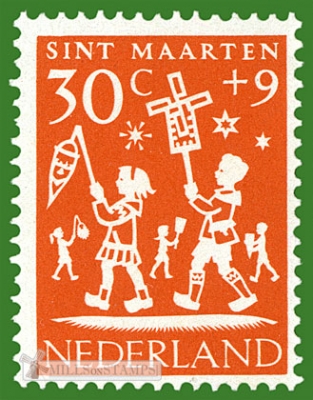-
Holiday folklore. Issue for child welfare
Netherlands 1961.11.13
In issue: Stamp(s): 5
-
Number by catalogue: Michel: 771 Yvert: 744 Scott: B362
Perforation type: 12 ½x12
Subject:
30+9 cents. Children with toy-ornaments at the St. Martin's Day*
Additional:
*St. Martin's Day (or Martinstag or Martinmas) is November 11, the feast day of Martin of Tours, who started out as a Roman soldier. He was baptized as an adult and became a monk. It is understood that he was a kind man who led a quiet and simple life. The most famous legend of his life is that he once cut his cloak in half to share with a beggar during a snowstorm, to save the beggar from dying of the cold. That night he dreamed that Jesus was wearing the half-cloak Martin had given away. Martin heard Jesus say to the angels: "Here is Martin, the Roman soldier who is not baptised; he has clothed me."
From the late 4th century CE to the late Middle Ages, much of Western Europe, including Great Britain, engaged in a period of fasting beginning on the day after St. Martin's Day, November 11. This fast period lasted 40 days, and was, therefore, called "Quadragesima Sancti Martini", which means in Latin "the forty days of St. Martin." At St. Martin's eve, people ate and drank very heartily for a last time before they started to fast. This fasting time was later called "Advent" by the Church.
Also, in the east part of the Belgian province of East-Flanders and the west part of West Flanders, children receive presents from St. Martin on November 11, instead of from Saint Nicholas on December 6 or Santa Claus on December 25.
Many churches in Europe are named after Saint Martinus, also known as Saint Martin of Tours. St. Martin is the patron saint of Szombathely, with a church dedicated to him, and also the patron saint of Quillota in Chile and Buenos Aires.
In Latin America, he has a strong popular following and is frequently referred to as San Martín Caballero, in reference to his common depiction on horseback.
Though no mention of St. Martin's connection with viticulture is made by Gregory of Tours or other early hagiographers, he is now credited with a prominent role in spreading wine-making throughout the Touraine region and facilitated the planting of many vines. The Greek myth that Aristaeus first discovered the concept of pruning the vines after watching a goat eat some of the foliage has been applied to Martin. He is also credited with introducing the Chenin Blanc grape varietal, from which most of the white wine of western Touraine and Anjou is made.
Martin Luther was purportedly named after St. Martin, as he was baptized on November 11 (St. Martin's Day), 1483.
Martinmas is a male holiday, since it honors a male saint. When men went singing and dancing door-to-door, one of the men was disguised as a woman.Topics: Stylized mills Various Windmills


